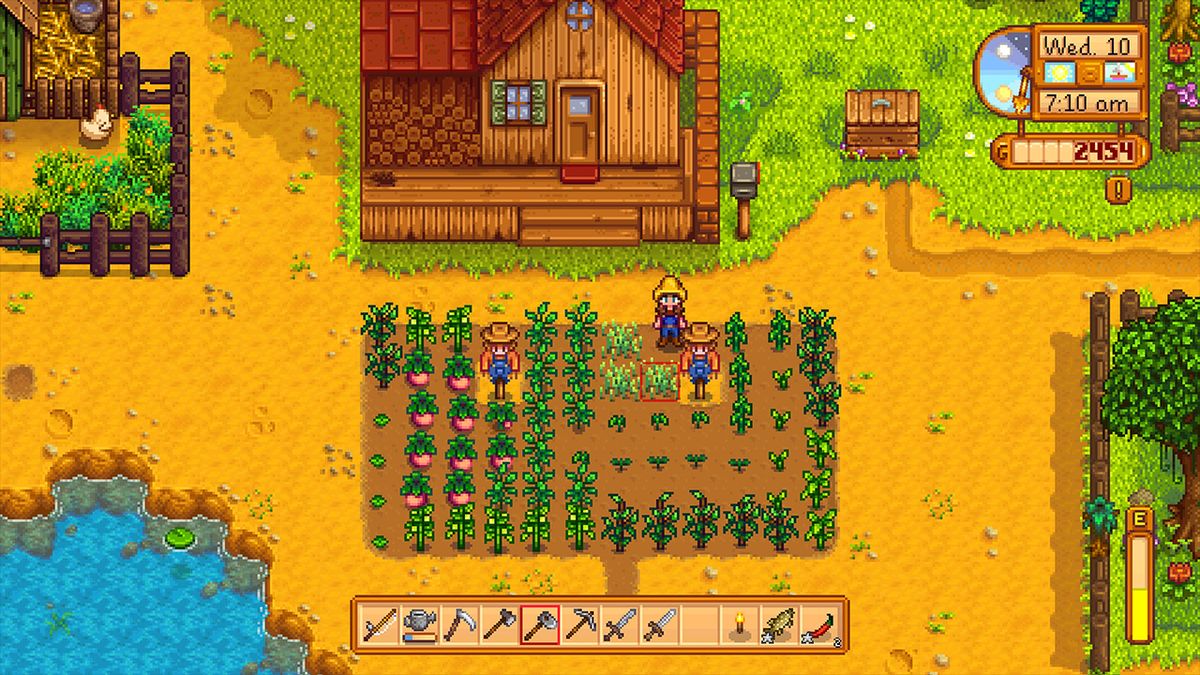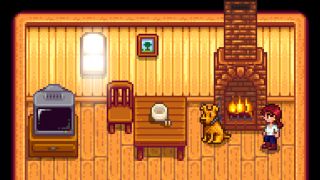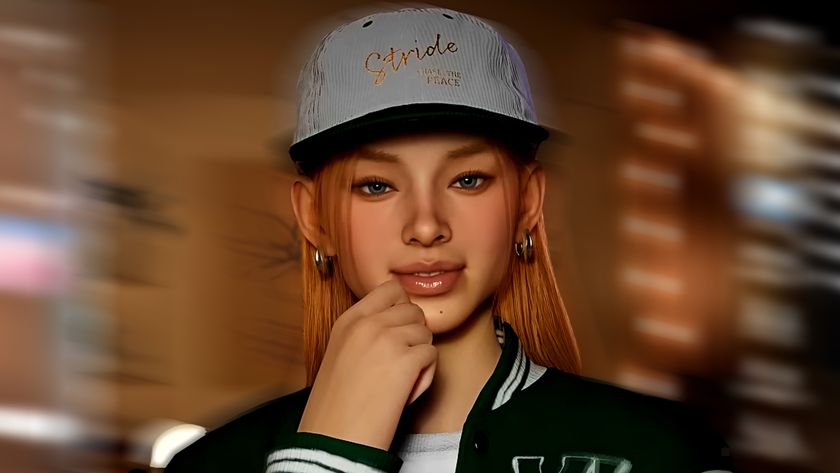Stardew Valley: How one of the best indie breakouts in years came from one fan's attempt to save his favourite game
How nostalgia, fandom, a can-do attitude, and a home-grown philosophy brought about an unlikely breakout hit.

Eric Barone’s favourite game series was stuck in a rut. By his reckoning, Harvest Moon had lost what had made the earlier games – the SNES original for which he’d first fallen, and his personal favourite, PlayStation entry Back to Nature – so special. He began to look for some kind of replacement, trawling through various fangames to little avail. There was only one thing for it: he’d have to make one of his own. “I guess I just hoped there were other people out there who felt the same as me, who were looking for this sort of thing,” he tells me.
It was a natural next step for Barone, who had already considered games as the ideal way to satisfy his creative urges. An avid artist, musician and writer of stories and poetry, he’d never quite imagined that he’d be able to make a living from his hobbies. But with a bachelor’s degree in computer science under his belt, he realised he had all the tools he needed. And now he had an idea to drive him forward.

Stardew Valley did, however, take quite some time to come together. As he started development, Barone had little meaningful experience, and a Steam release seemed beyond his capabilities. Xbox Live’s Indie Games service appeared to be his best option. Barone was already using Microsoft’s XNA programming framework, which was well-suited to making console games, and he believed he could clear XBLIG’s comparatively low quality bar, sell his game for a dollar or two, and move on. Obviously things didn’t quite pan out as he’d planned. After working on the game for a while, Barone built a website to document his progress, posting regular updates and attracting a small audience of regular followers. “That there were people out there who were really interested in what I was doing, and seeing that they would love a game like this, inspired me to go further,” he says.
Before long, he’d noticed a clear improvement in his skills as a developer. His pixel art was getting better; likewise his programming. Which meant an obvious discrepancy between ideas he’d worked on earlier in development and those that came later. “At some point I realised that this game wasn’t good enough; that I could do better,” he recalls. “So I went back and redid it all. I went through that process many times throughout development – I’d go back and redo everything again to get it up to the level that I was at presently.”
Cashflow was a concern, of course. Barone had a part-time job as a theatre usher to supplement his girlfriend’s grad-school income so they could scrape by, but the rest of his time was spent working on the game. “There was definitely pressure to make money, and so I guess that was one motivator,” he laughs. Barone had consciously isolated himself from the independent scene throughout development, but he was aware that the likes of Minecraft and Terraria had benefitted from its makers being active online. Having publicly announced the game in the autumn of 2012, he took to Twitter and Reddit to further discuss his work, and to more directly engage with the community that was steadily growing around the game.
A home-grown approach

“I had a sense that this was what you were supposed to do, but it was just natural for me to do it,” he says. “I like to be personal with people who are interested in my game, to treat them like real people. And a big part of the charm of Stardew Valley is that it’s a personal game. I felt that interacting with people in a straightforward way, with no PR-speak, made sense.”
Still, he did have some help getting the message out. By now, Stardew Valley had attracted the attention of publisher/developer Chucklefish, which offered to help Barone with promotion and marketing. “They weren’t involved in development at all, just the business side of things,” he says. “Them tweeting about the game and promoting it a little bit helped start the ball rolling, and at that point people who knew Harvest Moon started to learn about it, and many of them thought it was cool, and shared it with their friends and so on.”
Sign up to the 12DOVE Newsletter
Weekly digests, tales from the communities you love, and more
Barone was a little uncomfortable, however, with Stardew Valley’s growing virality. The game was in a distinctly unvarnished state at the time, and inevitably he’d begun to attract his fair share of internet vitriol. “There were plenty of people back then that were saying, ‘Oh, this is just a Harvest Moon rip-off, it’s garbage’,” he laughs. “But I kept improving it and the more I did that, the more I polished it and made it its own thing, I noticed people were saying that sort of thing less and less.”

Among the barbs, he found plenty of constructive feedback, which helped shape the direction of the game. Barone’s monthly update posts would attract a barrage of comments, and he’d read every one and try, wherever possible, to accommodate any popular feature requests. Community pressure took him down the occasional cul-de-sac: he’d stoked excitement among his community by telling them he was building procedurally generated open-world mines, but having spent several months working on them, he had to scrap them in favour of a more hand-crafted approach. “I’d got about 75 per cent of the way with that; I had goblin cities and all kinds of things in there,” he says. “But then it turned out that it wasn’t fun, and it was full of bugs.”
Still, he feels the feedback he got from his audience was a net positive. “Sometimes listening to the community led me astray a bit, but overall it was important to get some outside perspective on what I was doing, and to incorporate that into the final product.”
Even while responding to – and acting upon – fan requests, Barone was keen not to lose sight of his original vision. He resurrected the easily understandable tile-based farming of the earlier Harvest Moon games, but he was also chasing something rather less tangible. “It’s hard to even put my finger on, but there was a certain magic to those earlier games, just a feeling you got when playing them, that I wanted to capture,” he says. Frustrated at the series’ lapses into cliché and anime tropes, he aimed to evoke the idealistic outlook of Back To Nature, but also to echo its thematic maturity – though he concedes that perhaps its hidden depths are rosetinted memories. “Maybe it wasn’t actually that deep, but when you were a kid it felt like it was hinting at a lot of stuff. There were adult problems that characters had – some people drank too much, things like that. My intention with Stardew Valley was that it was for people my age, so I wanted to have themes that were compelling to adults but at the same time maintain a certain lightheartedness to keep it fun and relaxing.”
A new forest from an old acorn

Though he was hoping to recapture the spirit of Back To Nature, Barone didn’t simply want to remake the game; rather, he wanted to add to it, to refine its ideas. One of the key changes he made was to the cooking mechanics. Instead of cooking for profit, farmers are encouraged to make meals that convey a range of character buffs, making their daily routines more efficient. “I wanted things to have purpose,” he says. “In Harvest Moon, the point of making different meals would really be to ship one just so you have a complete shipping record – and of course some of the townsfolk might prefer a specific meal. But I felt it would be more fun if you had a real incentive to do it.”
Despite these additions, Barone was still concerned Stardew Valley might be considered a little too close to its biggest inspiration for comfort. “Yeah, I was definitely worried,” he admits. “For a long time I thought I was going to get sued. Though this was before I fully understood copyright law.” It was, then, a relief when he eventually met Yasuhiro Wada, Harvest Moon’s creator, and found not only a kindred spirit, but an appreciative fan: “I thought Mr Wada would be mad at me. But he was a really nice guy, he liked Stardew Valley, and thought it was great that someone was taking his idea and continuing it.”
Perhaps, I suggest, Wada had moved on from the series with which he’d made his name for similar reasons to Barone. “He basically said as much, yeah,” he nods. “We discussed the tile concept and he said that in the more modern games they keep getting smaller and smaller, whereas in the original Harvest Moon the tiles were nice and big and easy to work with, so you could wrap your head around it.”
An unexpected bounty

Barone wrapped up development in early 2016, releasing the PC version of Stardew Valley in February. His initial hope that there might be enough like-minded people seeking an old-school farming game was not misplaced: by the end of 2016 his game wasn’t far short of selling its two millionth copy, having comfortably outstripped the likes of Dishonored 2 and Mafia 3 in both sales and revenue on Steam. He’d already told friends he’d be “ecstatic” if the game managed to shift 100,000 copies over its lifetime; this was well beyond his wildest dreams. “At that point, I had no idea what was going on,” he laughs.
He was still keen to continue working on and improving Stardew Valley, but success quickly proved overwhelming. Barone was too busy with bug fixes, patches and updates to think about the future of the game, or to develop any kind of business plan. Chucklefish duly stepped in and offered its assistance, which he gladly accepted. The publisher ported the game to PS4 and Xbox One – with Barone merely having to approve any changes – and translated the game into six languages besides English.
It also connected him with merchandisers, while the multiplayer component he’d hoped to include with the original release started to take form. “It’s all the stuff I basically don’t want to do, because I just like to make games,” he says. “I like to create the art, the music, the story – that’s the kind of thing I like doing, not the highly technical stuff. Chucklefish has taken over all of that for me and I really appreciate it. It’s been a big help.”

He admits, with disarming candour, that even now he’s surprised at Stardew Valley’s reception – especially when he plays other indie games. “Like Hollow Knight, which I’m playing right now. Some of these games are like beautiful works of art, whereas Stardew Valley is very scrappy, it’s very amateur, and somehow everyone loves it.” I suggest that in that regard it has something in common with the likes of Terraria and Minecraft, both of which proved phenomenally popular despite – or perhaps as a result of – their comparatively rudimentary looks. “Yeah, I agree with you,” he replies, “And that was certainly intentional.” He pauses momentarily. “I guess it makes some kind of sense in retrospect. I obviously love games like Harvest Moon and Animal Crossing, but I wasn’t sure that it would be mainstream popular, you know?”
In a sense, Barone’s journey mirrors that of Stardew Valley’s protagonist. As an outsider you must build your farm up from scratch, toiling away over a substantial period of time, suffering setbacks and making mistakes before you can eventually reap the rewards of your efforts. It’s a game that rewards passion and good old-fashioned graft: two attributes that got Barone where he is now. “It didn’t really come together until the very end,” he says. “I spent a few months adding little flourishes and details to things, like woodpeckers pecking on the trees and stuff like that. That was when I started to think, ‘OK, this game is pretty special, it has that [Harvest Moon] magic to it’. And it’s a big game. I mean, it’s kind of crazy how much content there is.” He laughs, almost in disbelief. “Man, it was a lot of work.”
This article originally appeared in Edge magazine. For more great coverage, you can subscribe here.

Chris is Edge's deputy editor, having previously spent a decade as a freelance critic. With more than 15 years' experience in print and online journalism, he has contributed features, interviews, reviews and more to the likes of PC Gamer, GamesRadar and The Guardian. He is Total Film’s resident game critic, and has a keen interest in cinema. Three (relatively) recent favourites: Hyper Light Drifter, Tetris Effect, Return Of The Obra Dinn.













The Sims 4's colorful competitor Paralives is bringing one of my favorite features from The Sims 3 back – the ability to customize literally everything

"They will cancel their subscription and your investors will have your head": This management sim about making the perfect MMO is so detailed it lets you play your own game





